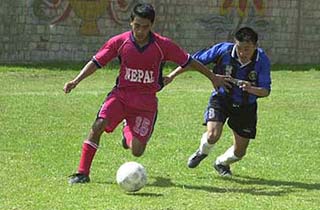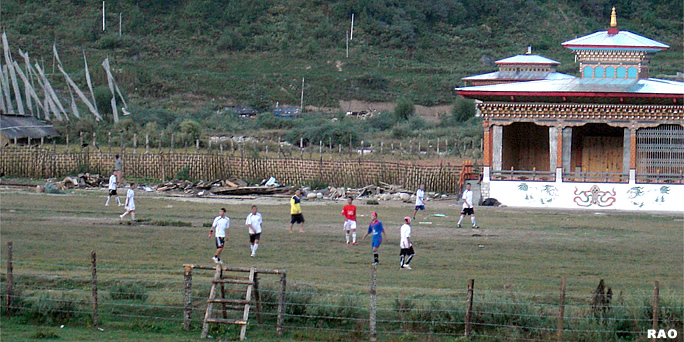 |
Bhutan's
Sports: Football |
|
 |
Bhutan's
Sports: Football |
|
|
 |
|
A
look at football in Bhutan
|

|
 |
Football tournament in Thimphu: Nepal vs Sikkim
Sitting
on a torn cardboard, 68-year old Ap Dorji watches two teams of 11 players
each attempting to guide an inflated ball into goal posts atopposite ends
of the Changlimithang ground.
Each time a striker rushes forward with the
ball accompanied by the deafening cries of the crowd, hestands up transfixed.
When the striker misses the shot, he gives a dejected grunt and sits down. |
|
In
Bhutan, continuous and fast-paced action in football have made it a major
spectator sport as elsewhere in the world. For the same reason it has attracted
many Bhutanese youth. Pele, arguably the greatest player to ever play soccer,
called it "the beautiful game". As wonderful as the game is, its origin
is shrouded in mystery. Experts believe that football was played as early
as 200 BC. Nobody is certain though how the game picked up in Bhutan.
An
official of the Bhutan Football Federation (BFF) says that it started in
the mid-fifties when schools were first opened in Haa and Paro. "Recruit
teachers from outside brought this game into our country," he says, "We
used to play with a small ball made from old garments." The playing field
those days was gravelly and hard on the knees and elbows when the going
got rough, he recalls.
A
veteran football star in the 1970s who is also reputed to have played in
the East Bengal club, Thimphu dzongda Dasho Karma Dorji, says that the
game actually picked up when Bhutanese went out to study. "These students
came back and popularised the game in Bhutan," he says. But during those
times, the game was hardly developed as a sport.
That
soccer had its proper basis in the late 1960s in Phuentsholing and Samtse.
Bhutanese youngsters used to hastily form a team and go to neighbouring
tea garden areas in India to play.
In
1968, the Bhutanese team comprising mostly hired players competed in the
Indian Independence Day cup in Calcutta. Over the years football became
increasingly popular. School curriculum was incomplete without the game.
Thimphu was flooded with high school tournaments. Schools as far as Khaling
used to come and battle enamoured suddenly with their new-found love. Bhutan
even had a strong national team. From 1970 to 1984, Bhutan had a top class
team. Teams from Bhutan participated in major tournaments outside and lifted
several trophies. Players were given a steady job in the civil service
and their "main duty" was to play football. About 60 percent of them were
from India.
The
Bhutanese national team were finalists four times in the ANFA cup (All
Nepal Football Association), an international tournament where teams from
China, Hongkong, India, Korea, Bangladesh and Sri Lanka used to contend.
|
What
happened after the star-studded era?
|
The
national team had no back up. There was simply no replacement for the older
players. The once looked upon Bhutan team slowly fizzled out. Some players
retired, some went back to their country. All along financial constraints
remained their main stumbling block. Dinesh Chhetri, the last man standing
of the bygone era, and still playing at 32 with Thimphu XI, says that back
in the 1980s they had to buy their own boots and dresses.
"When
we went for tournaments outside the country, we were given Nu 50 as pocket
money," he says, adding that although the governmentsupported the development
of football, there simply was not enough money. "It's because there
were other pressing priorities like health and education," says Khare.
The last straw was the dismal performance in Kuwait. Bhutan's team got
20 goals from Kuwait. Nothing ever motivated us more than that event. Bhutan
was more than ever determined to improve its football standard.
|
Bhutan
got the FIFA membership
|
On 5 August 2000 Bhutan was adopted as the 204th member of the FIFA family during the 52nd Ordinary Congress in Zurich. In 2000 there were about 900 amateur players, with about 1500 juniors under 15, 500 under 17 and 200 under 20. There are also 250 licensed women players. The Bhutan Football Association was founded in 1983. Since 1994 Bhutan is member of the Asian Football Confederation (AFC).
With
the FIFA (Federation Internationale de Football Association) membership,
the scenario in Bhutan is likely to change. The BFF has already acquired
six acres land at Changjiji where it will have its headquarters and hostels,
and fields for the selected football players under 14, 16 and 19. Funded
by FIFA, the project costing $400,000 will start next year. There are even
plans of building a national stadium at Babesa. Besides the coaches at
various schools, the BFF has three coaches certified by the AFC (Asian
Football Confederation). Presently there are nine clubs. The most
expensive player gets Nu 5,500 monthly aside from coaching, equipment and
free lodging. Players must go outside to get more exposure.
 |
| Contributed
byKuensel, Bhutan's National Newspaper |
| Information on Bhutan |
 |
|


